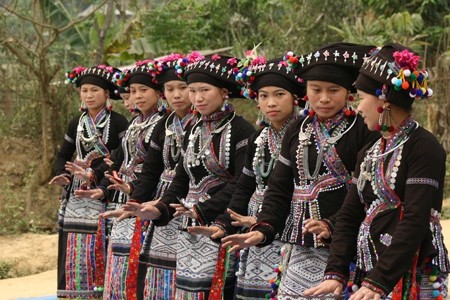The Lao people are a Tai ethnic group native to Southeast Asia. They primarily speak the Lao language, which belongs to the Kra–Dai language family. Lao people constitute the majority ethnic group of Laos, comprising 53.2% of the country’s total population. They are also found in significant numbers in northeastern Thailand, particularly in the Isan region, as well as in smaller communities in Cambodia, Vietnam, and Myanmar.
Culturally and linguistically, the Lao are closely related to other Tai peoples, especially the Thai and Isan people of Thailand. The majority of Lao people adhere to Theravada Buddhism, which plays a central role in their cultural and social life. However, animist beliefs and practices also remain influential, particularly in rural areas.
Historically, the terms “Lao” and “Laotian” have been used inconsistently in Western literature. Prior to Laos gaining independence from French colonial rule in 1953, these terms were often applied interchangeably to all inhabitants of Laos, regardless of their ethnic background. Since independence, “Lao” has come to refer specifically to the ethnic group, while “Laotian” denotes any citizen of Laos, irrespective of ethnicity. However, some countries and international organizations continue to use these terms interchangeably in their demographic statistics.
Names
The etymology of the term “Lao” remains uncertain, although it is potentially connected to ethnic groups identified as the “Ai Lao” (Lao: ອ້າຍລາວ, Thai: อ้ายลาว, Chinese: 哀牢; pinyin: Āiláo, Vietnamese: Ai Lao) mentioned in Han dynasty historical records residing in what is now Yunnan Province. Tribes descended from the Ai Lao included the Tai tribes that migrated to Southeast Asia.
According to the French linguist Michel Ferlus (2009), the ethnonym and autonym of the Lao people (ລາວ); nationality of the inhabitants of Laos is formed by the monosyllabization of the Austroasiatic etymon for ‘human being’ *k.raw.The peoples named Lao (lǎo 獠), supposed to be the ancestors of Lao and some other Tai-Kadai populations, settled in the upper Tonkin and in parts of Yúnnán and Guìzhōu during the Táng times
Subdivisions of the Lao people
In Laos, little distinction is made between the Lao and other closely related Tai peoples with mutually intelligible languages who are grouped together as Lao Loum or ‘Lowland Lao’ (Lao: ລາວລຸ່ມ láːu lūm , Thai: ลาวลุ่ม, IPA: laːw lum). Most of these groups share many common cultural traits and speak dialects or languages that are very similar, with only minor differences in tones, vocabulary, and pronunciation of certain words, but usually not enough to impede conversation, but many of these groups, such as the Nyaw and Phuthai consider themselves distinct, and often have differences in clothing that distinguish them
History
Map showing linguistic family tree overlaid on a geographic distribution map of Tai-Kadai family. This map only shows general pattern of the migration of Tai-speaking tribes, not specific routes, which would have snaked along the rivers and over the lower passes.
Early Chinese records employed the term Yue to denote the non-Han Chinese people south of the Yangtze. During the Spring and Autumn period (770-475 BC), the term was applied to a state on the southeast coast which was destroyed in 334 BC as the Han Chinese moved across the Yangtze and into the south. Subsequently, the term “Hundred Yue” was applied generically to the subjugated non-Han Chinese peoples in the south, with modifiers to denote groups in different locations or with some other distinguishing characteristics (Phomphan 1988). The term Yue fades from usage around 0 AD as the Chinese gained more knowledge of the southern peoples and began using other descriptors (Barlow 2001, chs. 1–2; Taylor 1983, 41–4). None of the modern terms used for Tai groups can be detected in these descriptors except Lao or Ai Lao people, which was applied to a variety of groups, mostly Hill-dwellers (Taylor 1983, 172; Cholthira 2001, 22–4).
This indicates that the Lao are at the very least a Proto-Tai group; perhaps even that all Tai groups are actually subgroups of these ancient Lao people, as there are no descriptors to indicate the existence of any group called Tai living south of the Yangtze, subsequently the first references of a group called Tai appeared in the 13th centuries, no such references of a group called or calling themselves Tai seem to exist.
Geographical distribution
There are around 3.6 million Laotians in Laos, constituting approximately 68% of the population (the remainder are largely hill tribe people). The ethnic Lao of Laos form the bulk of the Lao Loum (“Lowland Laotians”) (Lao: ລາວລຸ່ມ, Thai: ลาวลุ่ม, IPA: laːw lum). Small Lao communities exist in Thailand and Cambodia, residing primarily in the former Lao territory of Stung Treng (Xieng Teng in Lao), and Vietnam.
There are a substantial number of Lao overseas, numbering over 500,000 people. Laotian migration outside of Indochina first occurred during French colonialism in Laos that started in the early 20th century. Lao students and workers came to France during this period, including members of the Lao royal family, and some resettled there permanently. However, most Lao migrants were refugees who fled Laos after the Laotian Civil War (part of the greater Vietnam War) and from the new communist Pathet Lao government. Primary places of asylum for the Lao refugees included the United States, France, Canada and Australia.Other countries such as France, Japan, Argentina, and Singapore also took in Laotian refugees.
The 2010 United States census reported over 200,000 Americans of Lao descent in the country, a figure which excludes Hmong and Mien, but may include individuals of Tai Dam, Khmu, and other descent in addition to the Lao due to confusions between national and ethnic identity. A 2012 estimate counted about 140,000 ethnic Laotians living in France, with over half of the population living in Paris and the surrounding Île-de-France area.
There are approximately 20 million Lao Isaan in Thailand, residing mainly on the Khorat Plateau in northeastern Thailand and in and around Bangkok. The government of Thailand has historically discouraged the Lao Isaan from identifying as or being identified as Lao.[citation needed]
Language
The Lao language is a tonal, analytic, right-branching, pronoun pro-drop language of the Tai–Kadai language family, closely related to Thai and other languages of Tai peoples. Most of the vocabulary is of native Tai origin, although important contributions have come from Pali and Sanskrit as well as Mon–Khmer languages. The alphabet is an indic-based alphabet. Although the Lao have five major dialects, they are all mutually intelligible and Lao people believe they all speak variations of one language.
Culture
Lao cuisine
Main article: Lao cuisine
A dish of Tam mak hoong, ping gai, and khao nio, a very common Lao meal.
The cuisine of Laos is similar to other regional cuisines such as Thai and Cambodian cuisines, but has several unique distinguishing traits. Lao cuisine’s most famous dishes are larb and green Papaya salad, both originated in Laos.The cuisines of the Lao in Laos and Isan have diverged only minutely, with the key differences is that Lao cuisine lacks the influences of Thai cuisine and Isan cuisine lacks many of the French influences in Laos. Rice is the staple, and the main variety is glutinous rice or khao nio (ເຂົ້າຫນຽວ, ข้าวเหนียว, [kʰàw nǐw]), which is also a feature on Isan and Northern Thai tables since both have been influenced by Lao cuisine. Although sometimes replaced by noodles or other, less popular varieties of rice, it is commonly served with an accompaniment of various dips and sauces, raw vegetables, and several dishes that are shared together. Many dishes are very spicy, fired by the numerous varieties of chili peppers and made pungent by the strong herbs and fermented fish sauces.
source: https://en.m.wikipedia.org/wiki/Lao_people



